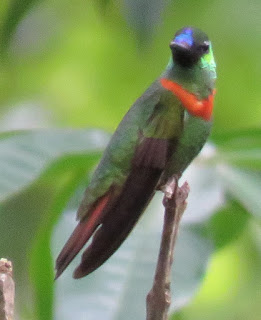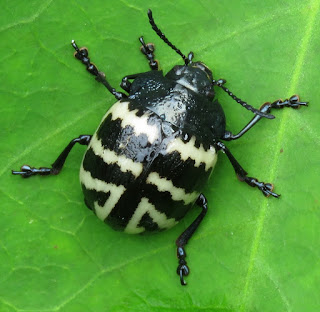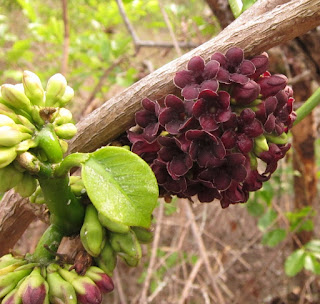This is the last day before the onslaught of my friends. I talked Susanne into going up to the Serra 1, an island of unique habitat in this sea of Amazonian rainforest. It turned out to be pretty interesting for fungi as well, but I mostly took photos of other things. It was a great morning.
Right where we got off the boat were two interesting plants, both lacking chlorophyll and probably mycoheterotrophic. Underground they connect with fungi to get the nutrients they would have otherwise photosynthesized. This one is Helosis cayannensis, family Balanophoraceae. Male and female flowers are borne on separate heads; these lack anthers and look like stigmas, so this is a female head.
This is Thismia hyalina, the most common of the four species that occur here. Currently this is in the family Burmanniaceae, but some consider Thismiaceae to be a valid split.
This time of year the top of the serra is a luxurious garden of fascinating plants in bloom. This gorgeous small tree in the family Rubiaceae is Coutarea hexandra. I’m surprised it’s not cultivated worldwide for such showy blossoms.
This used to be Ananas ananassoides, but recent genetic studies have determined that all the various Ananas species are all merely subspecies or varieties of the same pineapple that has been cultivated for thousands of years, Ananas comosus.
For the first time I found a Dracontium growing up here – an aroid with a single leaf that in age gets huge, and at maturity sports an enormous foul-smelling spathe and spadix. I don’t know if the plant dies after blooming like agaves, but I would expect to see a lot of big ones around if not. This genus has never been recorded at Cristalino before.
This Gould's Jewelfront landed in plain sight while I was watching a mixed flock move through. I’ve seen very few here, and one of the top birding guides at Cristalino, Sidnei, still hadn’t ever seen one. This one turned out to be the first of a wave of arrivals (from where, no one knows), and in the next weeks he would find several more.
This is a Yellow-olive Flycatcher of the pallescens subspecies. The serras at Cristalino are a far northern outpost for this cerrado form, and they are either super hard to detect in the dry season or are migratory.
Only in the rainy season can you find the lovely damselfly Austrotepuibasis manolisi. I’ve blogged about this before: it’s named after Tim Manolis. I showed this insect to Tim in 2006, when it wasn't known what it was (I had first found it in 2004 along with David Nunnallee). Tim collected a couple specimens and gave them to Frederico Lencioni in São Paulo, and it turned out to be a new species and genus; Frederico named it after Tim. Austrotepuibasis hoyernunnalleeorum would have been an awful name anyway.
At first glance I thought this was an obvious pleasing fungus beetle. The problem was it was feeding on the thick leaves of a milkweed, Marsdenia macrophylla (which blooms only in the very start of the rainy season, in October). I also noted that it doesn’t have the club-shaped tips to the antennae, so I presume it’s a mimic in the leaf-beetle family Chrysomelidae.
Here are some flowers of Marsdenia macrophylla from October 2, 2011:
A very showy jumping spider living in a terrestrial bromeliad, this is a Psecas sp.
A tiny cicadellid leafhopper with a fulgorid-like projection, this is Raphirhinus phosphoreus.
Finally, here is the smallest dung beetle I have ever seen – probably just under 1 cm. Only with my macro photo did I see that it bore two horns on its clypeus.


















Excellent as always. I saw that the damselfly was manolisi, so I sent an email to Tim M. He confirmed he collected it at Cristalino. He gave it to a Brazilian odonatologist who described it, as it was new to science. Tim didn't expect it to be named after him.
ReplyDeleteHi Rich, just out of curiosity, which subspecies Yellow-olive Fly is down below in the rainforest then?
ReplyDelete